Degradation of Mechanical Properties of Flax/PLA Composites in Hygrothermal Aging Conditions
Abstract
:1. Introduction
2. Materials and Methods
3. Experimental Tests
3.1. Aging and Tensile Tests
3.2. Contact Angle Experiment and Surface Energy
3.3. Infrared Spectroscopy
3.4. Thermal Characterization
4. Results
4.1. Mechanical Response of Hygrothermally Aged Flax/PLA Samples
4.2. Moisture Absorption
4.3. Contact Angle
4.4. Infrared Spectrum
4.5. Thermal Characterization
5. Conclusions
- The hygrothermal aging condition considerably influences the mechanical behavior of the biocomposite. It produces a drastic reduction in stiffness in the first 24 h and ends up with a maximum of 72% less than the unaged samples in 6 weeks. The biocomposite also suffers a loss of nonlinearity of the stress–strain curve. In addition, a reduction in the material strength of 14% is observed, but only after aging times higher than three weeks.
- The effect of the APPT treatment on the tensile strength and stiffness is negligible because it does not modify the C=O, C–O, and C–O–C bonds, which are necessary to improve the fiber–matrix compatibility. However, plasma treatment has notably improved the adhesion of the PLA polymer with the flax fiber according to the SEM scans.
- On the other hand, plasma treatment does not significantly increase the moisture absorption of the flax/PLA samples under high-humidity conditions. However, it does make the treated fiber biocomposites saturate sooner than untreated fiber biocomposites, producing water desorption. In addition, the wettability of the material is also enhanced.
- The maximum aging time of hygrothermal aging conditions is six weeks. The stiffness degradation is stabilized at this time, but the strength can probably decrease for higher aging times.
- After 42 days of aging tests, the biocomposite deterioration produces a stiffness reduction of 72% and a strength reduction of 31%.
Author Contributions
Funding
Institutional Review Board Statement
Data Availability Statement
Conflicts of Interest
References
- Georgios, K.; Silva, A.; Furtado, S. Applications of Green Composite Materials. In Biodegradable Green Composites; Wiley: Hoboken, NJ, USA, 2016; pp. 312–337. [Google Scholar]
- Mann, G.S.; Singh, L.P.; Kumar, P.; Singh, S. Green Composites: A Review of Processing Technologies and Recent Applications. J. Thermoplast. Compos. Mater. 2020, 33, 1145–1171. [Google Scholar] [CrossRef]
- Giełdowska, M.; Puchalski, M.; Sztajnowski, S.; Krucińska, I. Evolution of the Molecular and Supramolecular Structures of PLA during the Thermally Supported Hydrolytic Degradation of Wet Spinning Fibers. Macromolecules 2022, 55, 10100–10112. [Google Scholar] [CrossRef]
- Cheng, M.; Zhong, Y.; Kureemun, U.; Cao, D.; Hu, H.; Lee, H.P.; Li, S. Environmental Durability of Carbon/Flax Fiber Hybrid Composites. Compos. Struct. 2020, 234, 111719. [Google Scholar] [CrossRef]
- Fragassa, C.; Pavlovic, A.; Živković, I. The Accelerated Aging Effect of Salt Water on Lignocellulosic Fibre Reinforced Composites. Tribol. Ind. 2018, 40, 1–9. [Google Scholar] [CrossRef]
- Zuccarello, B.; Militello, C.; Bongiorno, F. Environmental Aging Effects on High-Performance Biocomposites Reinforced by Sisal Fibers. Polym. Degrad. Stab. 2023, 211, 110319. [Google Scholar] [CrossRef]
- Chilali, A.; Zouari, W.; Assarar, M.; Kebir, H.; Ayad, R. Effect of Water Ageing on the Load-Unload Cyclic Behaviour of Flax Fibre-Reinforced Thermoplastic and Thermosetting Composites. Compos. Struct. 2018, 183, 309–319. [Google Scholar] [CrossRef]
- Yu, T.; Sun, F.; Lu, M.; Li, Y. Water Absorption and Hygrothermal Aging Behavior of Short Ramie Fiber-reinforced Poly(Lactic Acid) Composites. Polym. Compos. 2018, 39, 1098–1104. [Google Scholar] [CrossRef]
- Hu, R.-H.; Sun, M.; Lim, J.-K. Moisture Absorption, Tensile Strength and Microstructure Evolution of Short Jute Fiber/Polylactide Composite in Hygrothermal Environment. Mater. Des. 2010, 31, 3167–3173. [Google Scholar] [CrossRef]
- Kabir, M.M.; Wang, H.; Lau, K.T.; Cardona, F. Chemical Treatments on Plant-Based Natural Fibre Reinforced Polymer Composites: An Overview. Compos. B Eng. 2012, 43, 2883–2892. [Google Scholar] [CrossRef]
- Tanasă, F.; Teacă, C.-A.; Nechifor, M.; Stanciu, M.-C. Physical Methods for the Modification of the Natural Fibers Surfaces. In Surface Treatment Methods of Natural Fibres and Their Effects on Biocomposites; Elsevier: Amsterdam, The Netherlands, 2022; pp. 125–146. [Google Scholar]
- Sánchez, M.L.; Capote, G.; Patiño, J.P. Effect of Surface Treatment of Fibers on the Accelerated Aging of Biocomposites. Constr. Build. Mater. 2021, 271, 121875. [Google Scholar] [CrossRef]
- Enciso, B.; Abenojar, J.; Paz, E.; Martínez, M.A. Influence of Low Pressure Plasma Treatment on the Durability of Thermoplastic Composites LDPE-Flax/Coconut under Thermal and Humidity Conditions. Fibers Polym. 2018, 19, 1327–1334. [Google Scholar] [CrossRef]
- Enciso, B.; Abenojar, J.; Paz, E.; Martínez, M.A. Effect of APPT Treatment on Mechanical Properties and Durability of Green Composites with Woven Flax. Materials 2020, 13, 4762. [Google Scholar] [CrossRef] [PubMed]
- Regazzi, A.; Corn, S.; Ienny, P.; Bénézet, J.C.; Bergeret, A. Reversible and Irreversible Changes in Physical and Mechanical Properties of Biocomposites during Hydrothermal Aging. Ind. Crops Prod. 2016, 84, 358–365. [Google Scholar] [CrossRef]
- Regazzi, A.; Corn, S.; Ienny, P.; Bergeret, A. Coupled Hydro-Mechanical Aging of Short Flax Fiber Reinforced Composites. Polym. Degrad. Stab. 2016, 130, 300–306. [Google Scholar] [CrossRef]
- Regazzi, A.; Léger, R.; Corn, S.; Ienny, P. Modeling of Hydrothermal Aging of Short Flax Fiber Reinforced Composites. Compos. Part. A Appl. Sci. Manuf. 2016, 90, 559–566. [Google Scholar] [CrossRef]
- Rubio-López, A.; Artero-Guerrero, J.; Pernas-Sánchez, J.; Santiuste, C. Compression after Impact of Flax/PLA Biodegradable Composites. Polym. Test. 2017, 59, 127–135. [Google Scholar] [CrossRef]
- Jiao-Wang, L.; Loya, J.A.; Santiuste, C. Influence of Cross-Section on the Impact and Post-Impact Behavior of Biocomposites Bumper Beams. Mech. Adv. Mater. Struct. 2022, 30, 1–12. [Google Scholar] [CrossRef]
- Jiao-Wang, L.; Loya, J.A.; Santiuste, C. On the Numerical Modeling of Flax/PLA Bumper Beams. Materials 2022, 15, 5480. [Google Scholar] [CrossRef]
- Jiao-Wang, L.; Larriba, C.; Santiuste, C. On the Experimental Validation of Ludwick Law to Predict Critical Buckling Load of Nonlinear Elastic Columns. Compos. Struct. 2023, 303, 116237. [Google Scholar] [CrossRef]
- Jiao-Wang, L.; Puerta-Hueso, S.; Pedroche, D.; Santiuste, C. Prediction of Critical Buckling Load on Open Cross-Section Columns of Flax/PLA Green Composites. Polymers 2022, 14, 5095. [Google Scholar] [CrossRef] [PubMed]
- ISO 1183—1: 2019; Methods for determining the density of non-cellular plastics. International Organization for Standardization: Geneva, Switzerland, 2019.
- Encinas, N.; Díaz-Benito, B.; Abenojar, J.; Martínez, M.A. Extreme Durability of Wettability Changes on Polyolefin Surfaces by Atmospheric Pressure Plasma Torch. Surf. Coat. Technol. 2010, 205, 396–402. [Google Scholar] [CrossRef]
- Brebu, M. Environmental Degradation of Plastic Composites with Natural Fillers—A Review. Polymers 2020, 12, 166. [Google Scholar] [CrossRef]
- Brdlík, P.; Novák, J.; Borůvka, M.; Běhálek, L.; Lenfeld, P. The Influence of Plasticizers and Accelerated Ageing on Biodegradation of PLA under Controlled Composting Conditions. Polymers 2023, 15, 140. [Google Scholar] [CrossRef]
- Owens, D.K.; Wendt, R.C. Estimation of the Surface Free Energy of Polymers. J. Appl. Polym. Sci. 1969, 13, 1741–1747. [Google Scholar] [CrossRef]
- Kassouf, A.; Ruellan, A.; Jouan-Rimbaud Bouveresse, D.; Rutledge, D.N.; Domenek, S.; Maalouly, J.; Chebib, H.; Ducruet, V. Attenuated Total Reflectance-Mid Infrared Spectroscopy (ATR-MIR) Coupled with Independent Components Analysis (ICA): A Fast Method to Determine Plasticizers in Polylactide (PLA). Talanta 2016, 147, 569–580. [Google Scholar] [CrossRef]
- Socrates, G. Infrared and Raman Characteristic Group Frequencies: Tables and Charts, 3rd ed.; John Wiley & Sons Inc.: Hoboken, NJ, USA, 2002; ISBN 0-471-85298-8. [Google Scholar]
- Chieng, B.W.; Ibrahim, N.A.; Yunus, W.M.Z.W.; Hussein, M.Z. Poly(Lactic Acid)/Poly(Ethylene Glycol) Polymer Nanocomposites: Effects of Graphene Nanoplatelets. Polymers 2014, 6, 93–104. [Google Scholar] [CrossRef]
- Kaiser, G.; Schmolzer, S.; Straber, C.; Pohland, S.; Turan, S. Handbook DSC Differential Scanning Calorimetry; NETZSCH-Gerätebau: Selb, Germany, 2015; pp. 76–77. [Google Scholar]
- Rubio-López, A.; Hoang, T.; Santiuste, C. Constitutive Model to Predict the Viscoplastic Behaviour of Natural Fibres Based Composites. Compos. Struct. 2016, 155, 8–18. [Google Scholar] [CrossRef]
- Díaz-Álvarez, A.; Jiao-Wang, L.; Feng, C.; Santiuste, C. Energy Absorption and Residual Bending Behavior of Biocomposites Bumper Beams. Compos. Struct. 2020, 245, 112343. [Google Scholar] [CrossRef]
- Fiore, V.; Valenza, A.; Di Bella, G. Artichoke (Cynara Cardunculus L.) Fibres as Potential Reinforcement of Composite Structures. Compos. Sci. Technol. 2011, 71, 1138–1144. [Google Scholar] [CrossRef]
- Tserki, V.; Zafeiropoulos, N.E.; Simon, F.; Panayiotou, C. A Study of the Effect of Acetylation and Propionylation Surface Treatments on Natural Fibres. Compos. Part. A Appl. Sci. Manuf. 2005, 36, 1110–1118. [Google Scholar] [CrossRef]
- Bozaci, E.; Sever, K.; Sarikanat, M.; Seki, Y.; Demir, A.; Ozdogan, E.; Tavman, I. Effects of the Atmospheric Plasma Treatments on Surface and Mechanical Properties of Flax Fiber and Adhesion between Fiber–Matrix for Composite Materials. Compos. B Eng. 2013, 45, 565–572. [Google Scholar] [CrossRef]
- Beltrán, F.R.; de la Orden, M.U.; Lorenzo, V.; Pérez, E.; Cerrada, M.L.; Martínez Urreaga, J. Water-Induced Structural Changes in Poly(Lactic Acid) and PLLA-Clay Nanocomposites. Polymer 2016, 107, 211–222. [Google Scholar] [CrossRef]
- John, M.J.; Anandjiwala, R.D. Recent Developments in Chemical Modification and Characterization of Natural Fiber-Reinforced Composites. Polym. Compos. 2008, 29, 187–207. [Google Scholar] [CrossRef]
- Li, H.; Huneault, M.A. Effect of Nucleation and Plasticization on the Crystallization of Poly(Lactic Acid). Polymer 2007, 48, 6855–6866. [Google Scholar] [CrossRef]
- Mathew, A.P.; Oksman, K.; Sain, M. The Effect of Morphology and Chemical Characteristics of Cellulose Reinforcements on the Crystallinity of Polylactic Acid. J. Appl. Polym. Sci. 2006, 101, 300–310. [Google Scholar] [CrossRef]




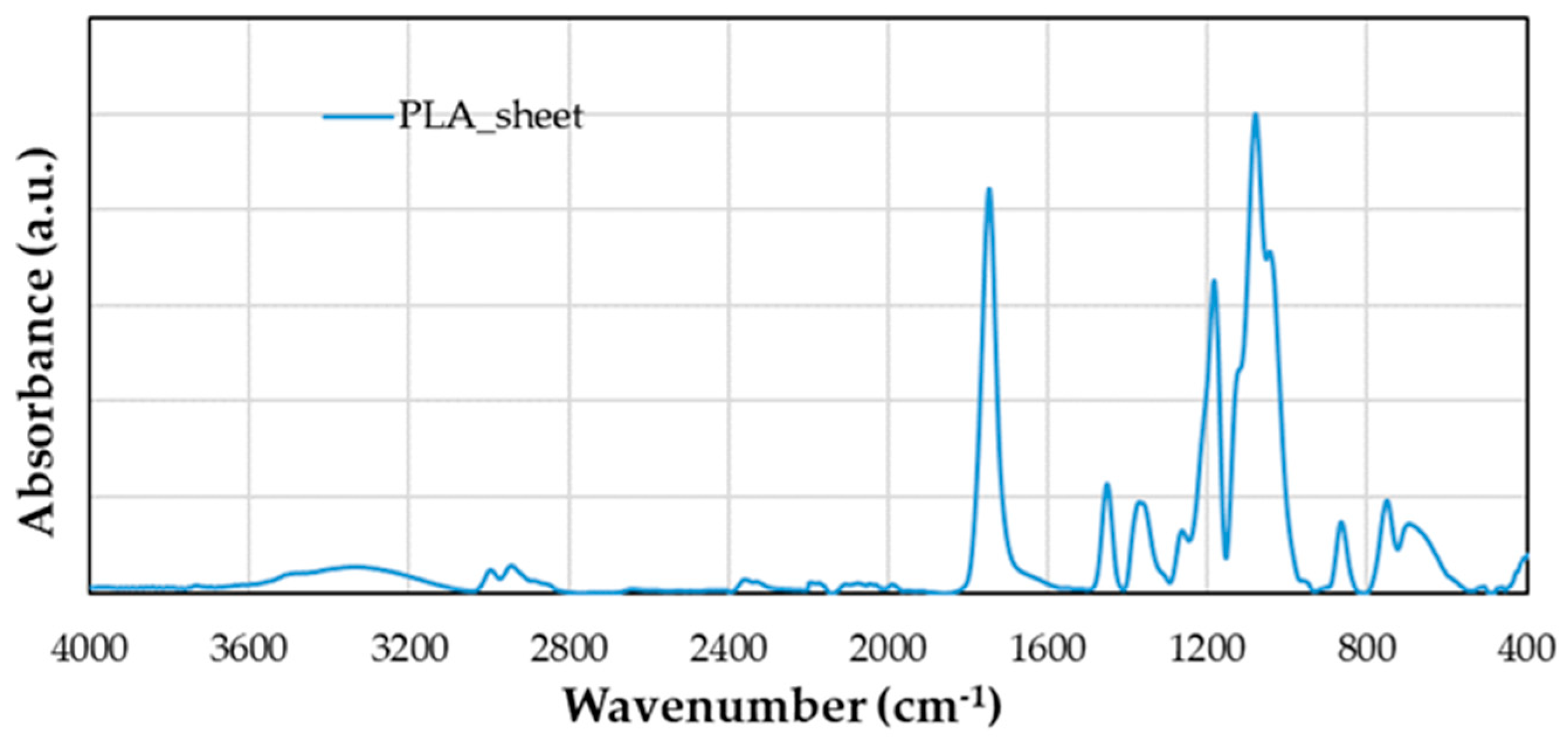
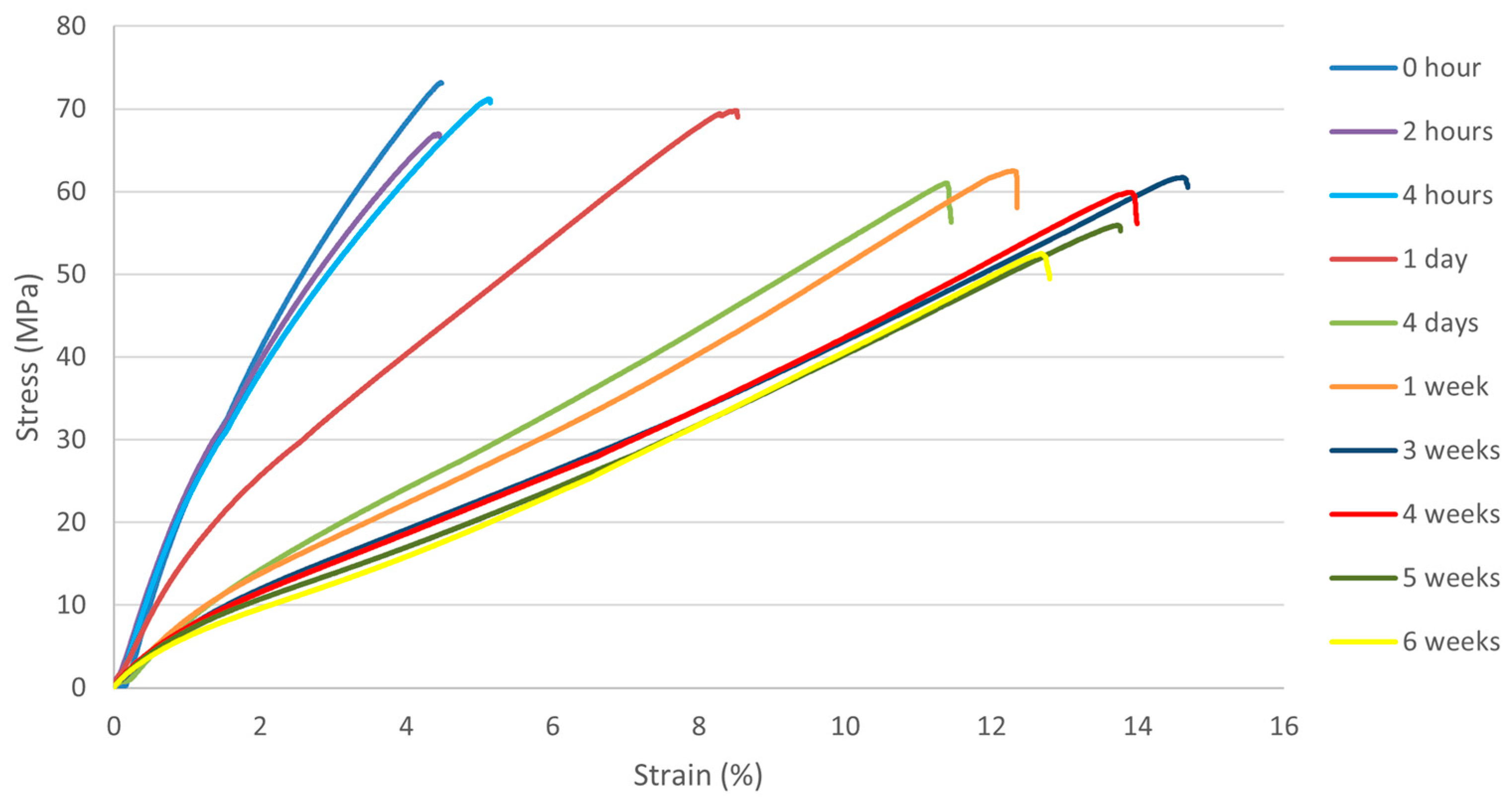
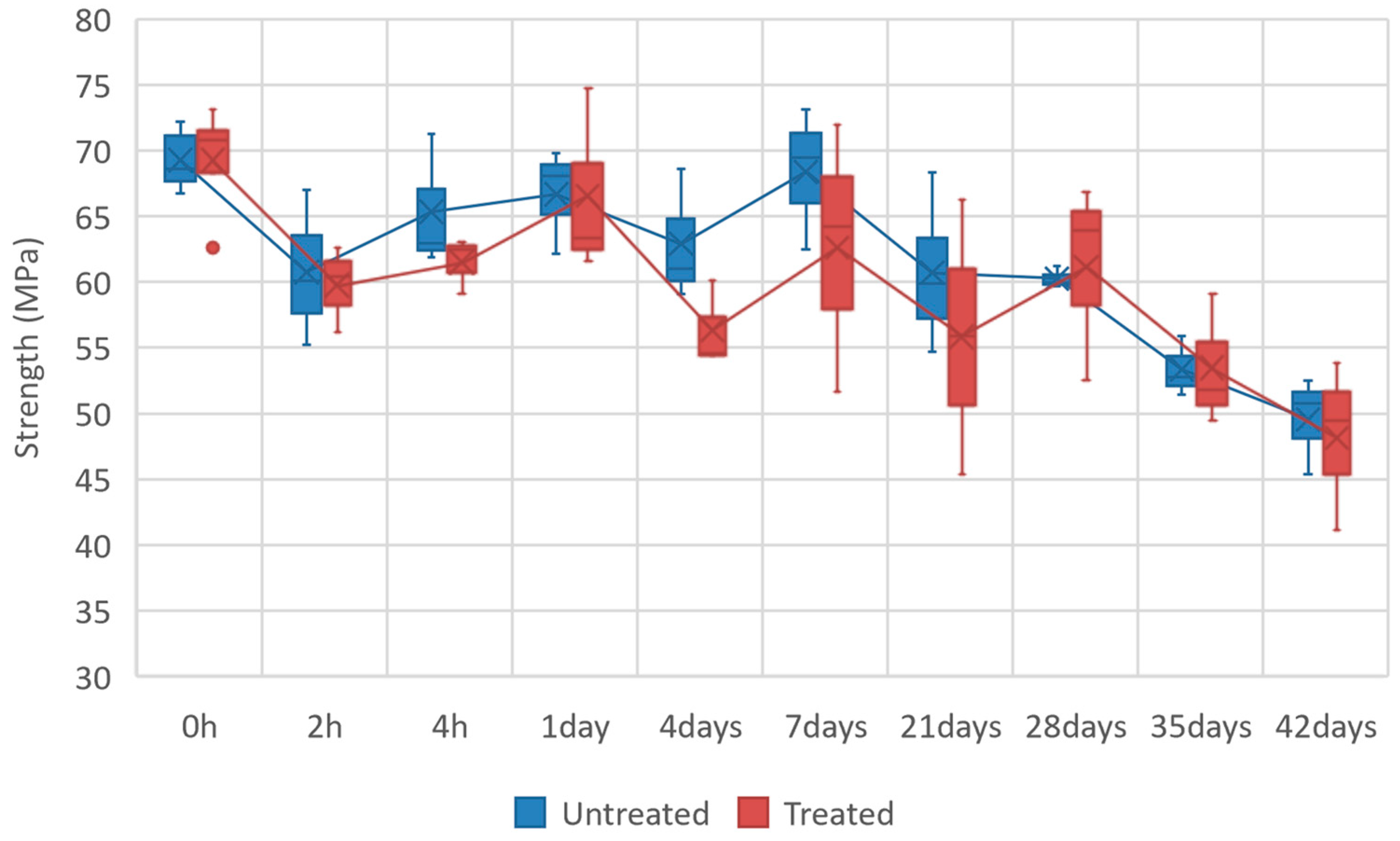
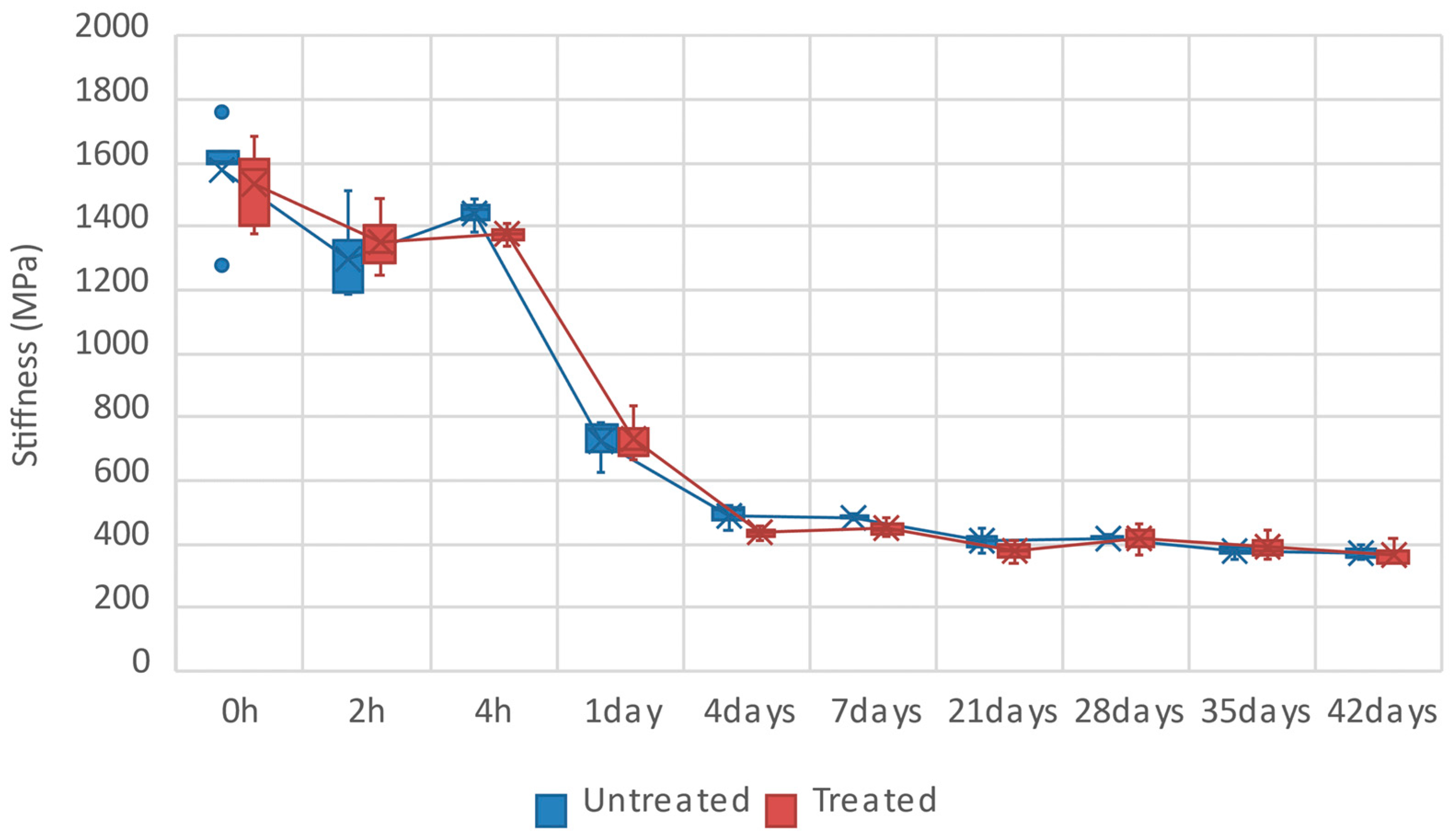

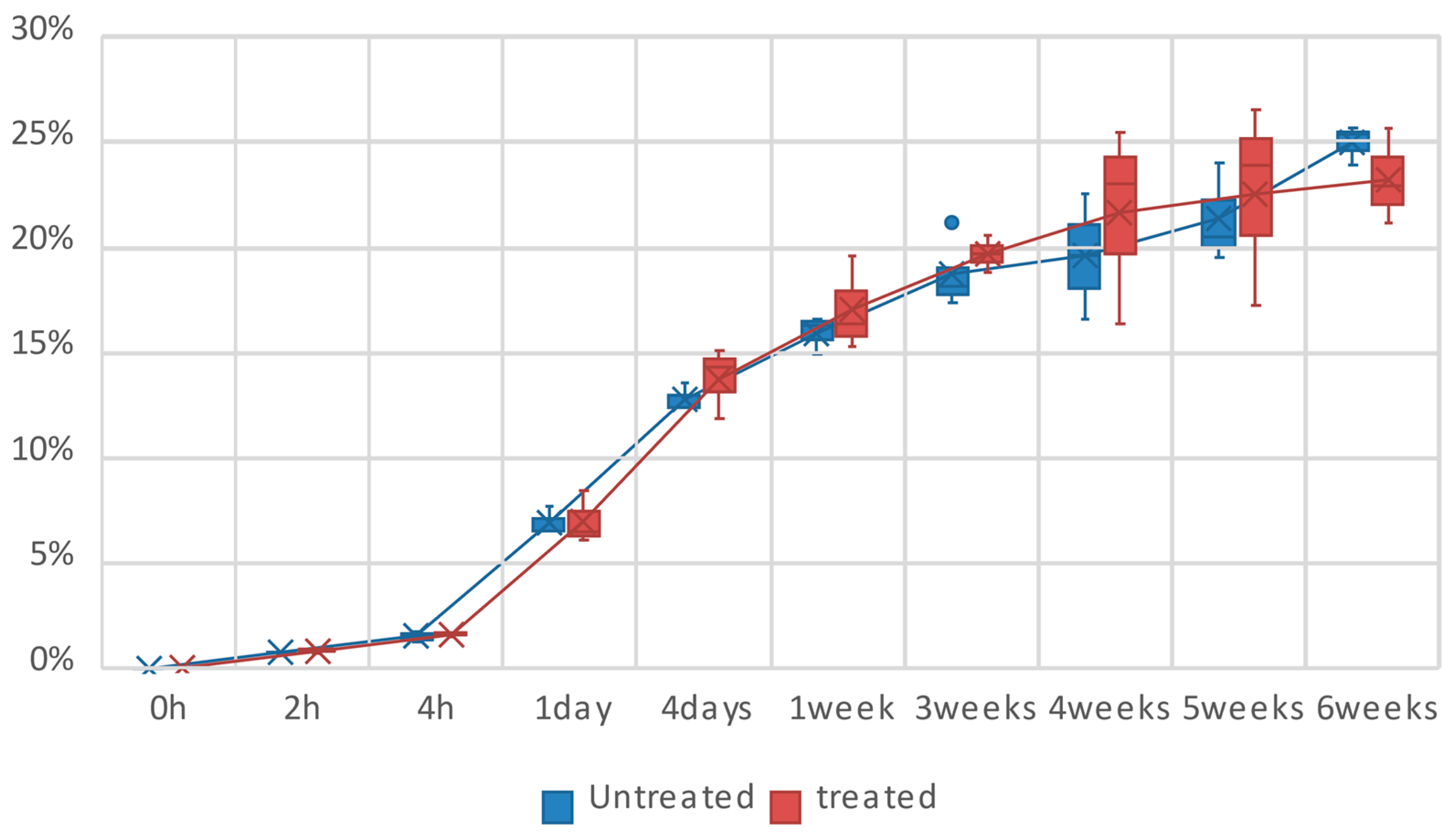
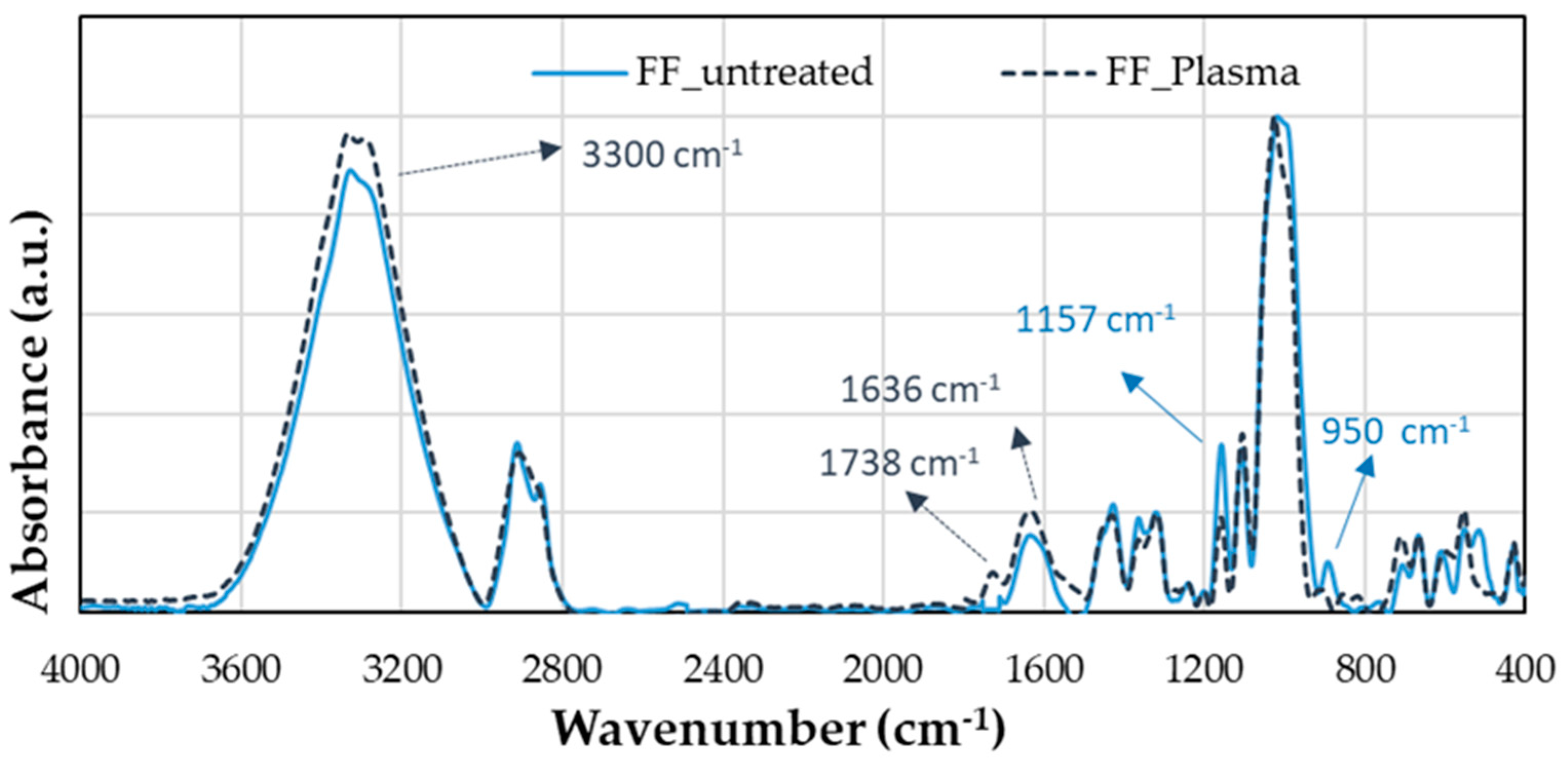

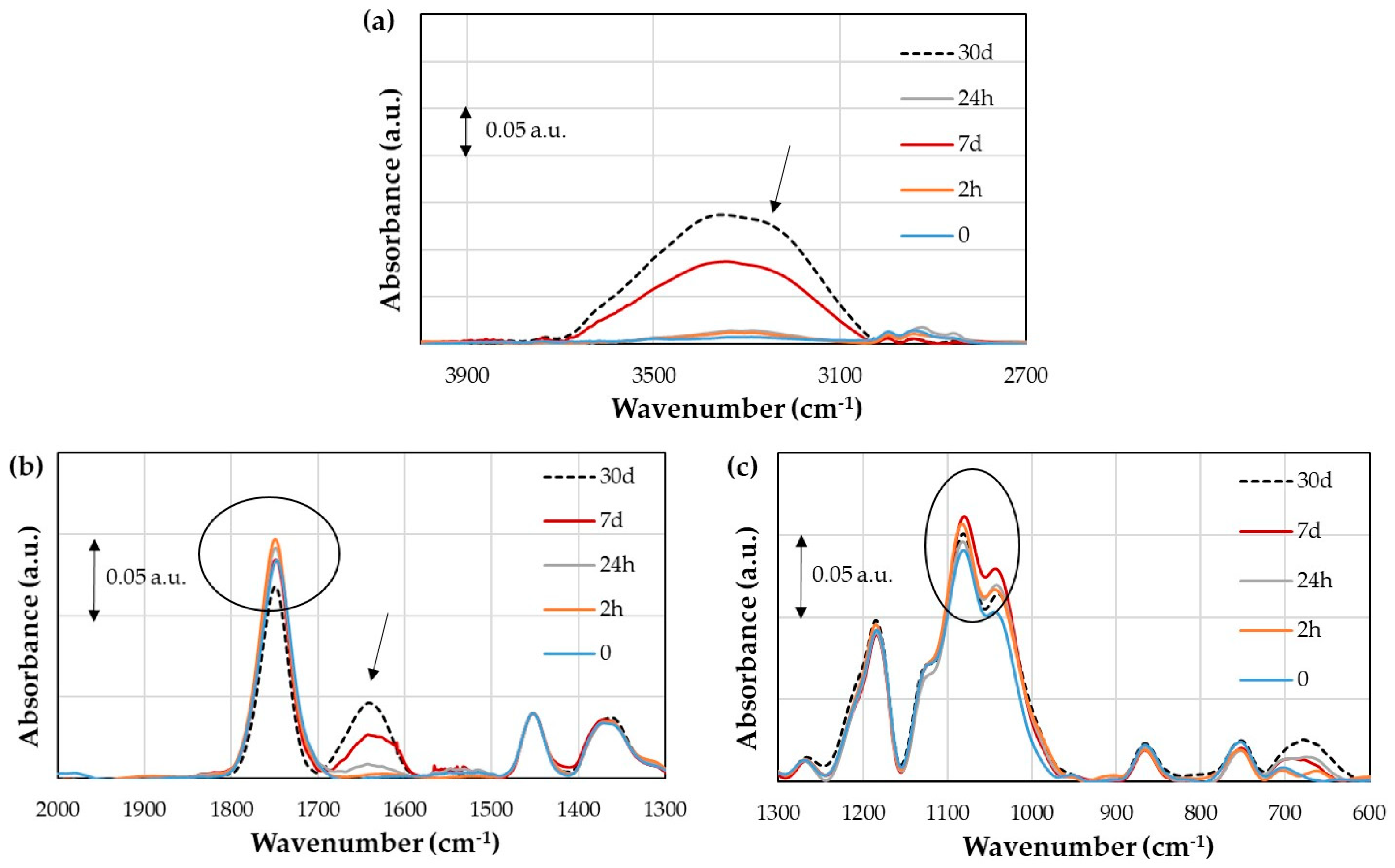
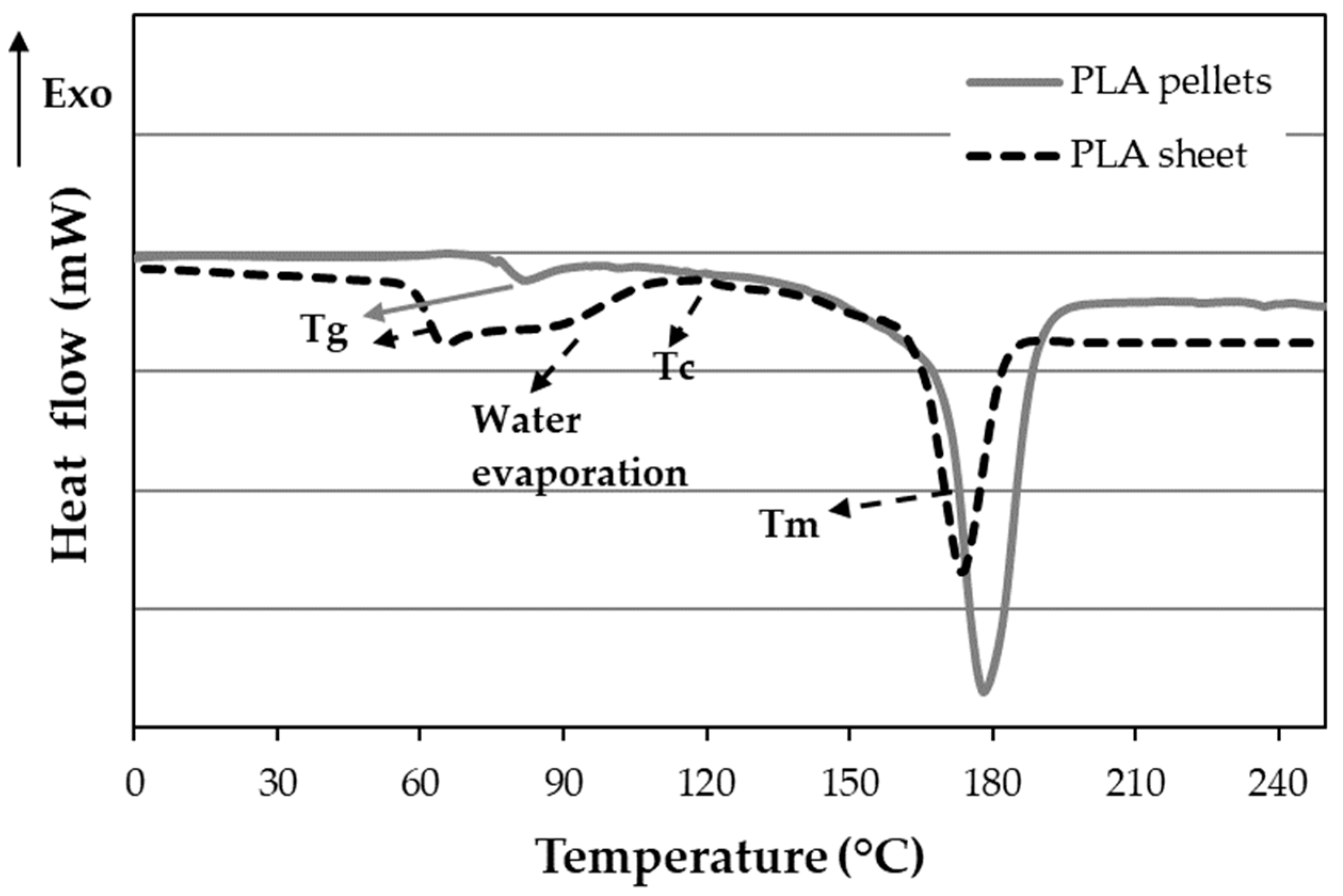
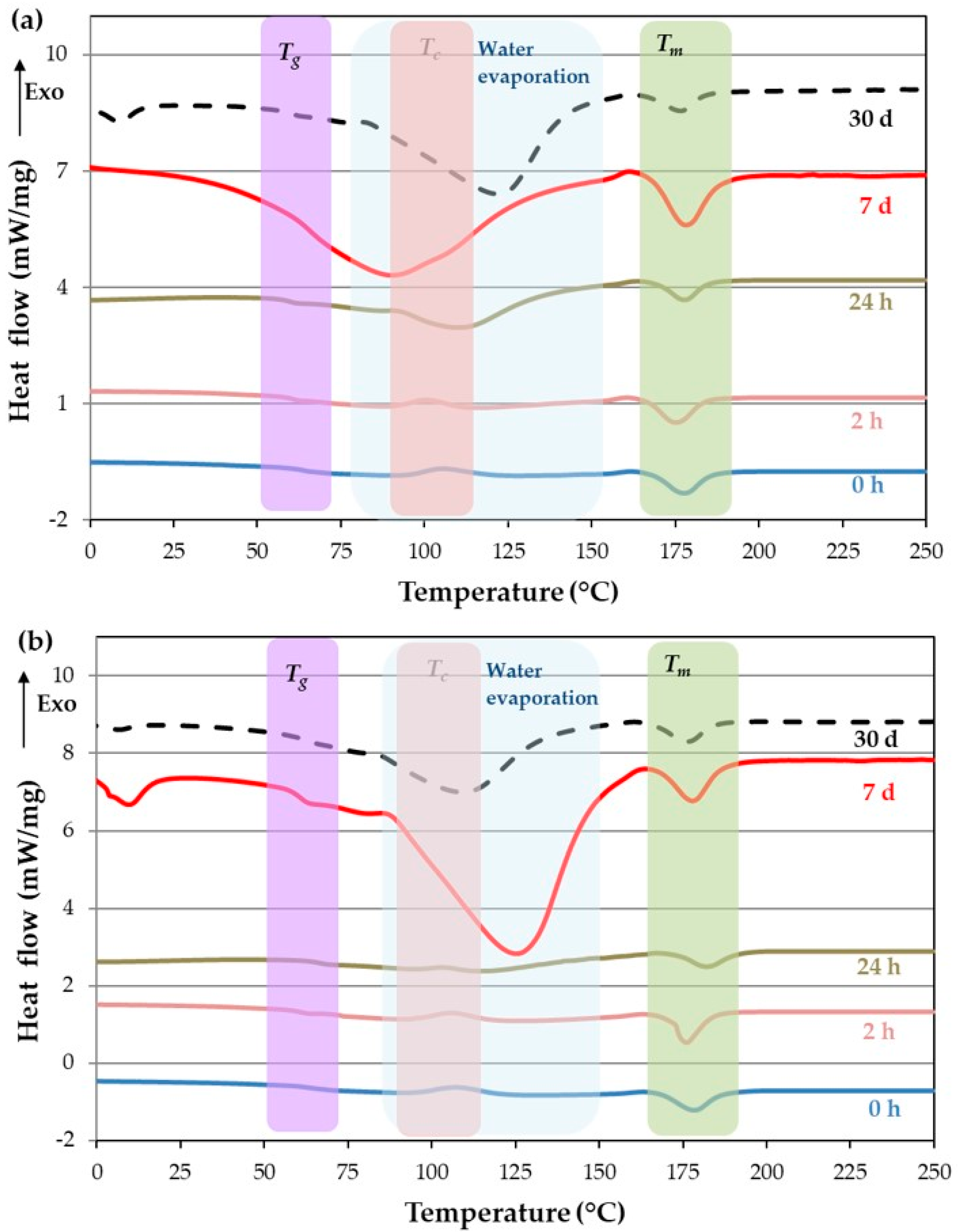
| Wavenumber (cm−1) | Vibrations | |
|---|---|---|
| 745 | C–H/C–O | bending |
| 857 | C–C | str * |
| 1039 | –C–CH3 | str |
| 1077 | C–O–C | asym * str |
| 1125 | C–H | rocking |
| 1182 | C–C/–C–O– | str |
| 1363 | C–O | str |
| 1447 | CH3–C–O | bending |
| 1747 | C=O | str |
| 2909 | C–H (CH3) | sym * str |
| 2981 | C–H (CH3) | asym str |
| 3071-3600 | OH | str |
| Liquids | Water | Glycerol | Diiodomethane | |
|---|---|---|---|---|
| Flax Fabric | Contact Angle (°) | |||
| Untreated | 136 ± 6 | 130 ± 3 | 92 ± 1 | |
| Plasma-treated | 53 ± 4 | 61 ± 3 | 32 ± 3 | |
| Flax Fabric | Surface Energy (mN/m) | ||
|---|---|---|---|
| Total | Dispersive | Polar | |
| Untreated | 15 ± 1 | 14 ± 1 | 1 ± 0 |
| Plasma-treated | 47 ± 2 | 34 ± 2 | 12 ± 2 |
| Aging Time | Flax | Composite Flax/PLA | |||||
|---|---|---|---|---|---|---|---|
| Tg (°C) | Tc (°C) | ΔHc (J/g) | Tm (°C) | ΔHm (J/g) | Xc (%) | ||
| 0 | Untreated | 63 ± 2 | 105 ± 2 | 6.9 ± 0.5 | 178 ± 1 | 19.9 ± 0.5 | 35 ± 3 |
| Treated | 64 ± 3 | 107 ± 1 | 8.1 ± 0.8 | 178 ± 2 | 17.2 ± 0.2 | 24 ± 2 | |
| 2 h | Untreated | 60 ± 1 | 101 ± 2 | 6.7 ± 0.2 | 175 ± 2 | 22.9 ± 0.8 | 43 ± 5 |
| Treated | 60 ± 2 | 106 ± 3 | 7.2 ± 0.4 | 176 ± 1 | 19.0 ± 0.3 | 31 ± 3 | |
| 24 h | Untreated | 59 ± 1 | 92 ± 5 | 1.0 ± 0.6 | 178 ± 2 | 15.3 ± 0.6 | 38 ± 4 |
| Treated | 59 ± 2 | 100 ± 3 | 1.8 ± 0.4 | 182 ± 3 | 12.1 ± 0.8 | 28 ± 2 | |
| 7 d | Untreated | 53 ± 2 | 178 ± 1 | 16.2 ± 0.7 | 43 ± 7 | ||
| Treated | 60 ± 4 | 87 ± 4 | 1.5 ± 0.7 | 178 ± 1 | 14.7 ± 0.4 | 35 ± 3 | |
| 30 d | Untreated | 60 ± 1 | 83 ± 5 | 2.4 ± 0.8 | 176 ± 2 | 14.0 ± 0.6 | 31 ± 2 |
| Treated | 57 ± 2 | 84 ± 3 | 1.0 ± 0.5 | 176 ± 1 | 18.9 ± 0.5 | 48 ± 8 | |
Disclaimer/Publisher’s Note: The statements, opinions and data contained in all publications are solely those of the individual author(s) and contributor(s) and not of MDPI and/or the editor(s). MDPI and/or the editor(s) disclaim responsibility for any injury to people or property resulting from any ideas, methods, instructions or products referred to in the content. |
© 2024 by the authors. Licensee MDPI, Basel, Switzerland. This article is an open access article distributed under the terms and conditions of the Creative Commons Attribution (CC BY) license (https://creativecommons.org/licenses/by/4.0/).
Share and Cite
Wang, L.; Abenojar, J.; Martínez, M.A.; Santiuste, C. Degradation of Mechanical Properties of Flax/PLA Composites in Hygrothermal Aging Conditions. Polymers 2024, 16, 528. https://doi.org/10.3390/polym16040528
Wang L, Abenojar J, Martínez MA, Santiuste C. Degradation of Mechanical Properties of Flax/PLA Composites in Hygrothermal Aging Conditions. Polymers. 2024; 16(4):528. https://doi.org/10.3390/polym16040528
Chicago/Turabian StyleWang, Liujiao, Juana Abenojar, Miguel A. Martínez, and Carlos Santiuste. 2024. "Degradation of Mechanical Properties of Flax/PLA Composites in Hygrothermal Aging Conditions" Polymers 16, no. 4: 528. https://doi.org/10.3390/polym16040528







